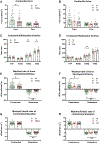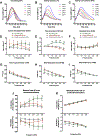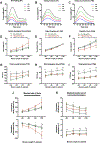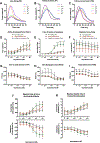Impact of etiology on force and kinetics of left ventricular end-stage failing human myocardium
- PMID: 33766524
- PMCID: PMC8217133
- DOI: 10.1016/j.yjmcc.2021.03.007
Impact of etiology on force and kinetics of left ventricular end-stage failing human myocardium
Abstract
Background: Heart failure (HF) is associated with highly significant morbidity, mortality, and health care costs. Despite the significant advances in therapies and prevention, HF remains associated with poor clinical outcomes. Understanding the contractile force and kinetic changes at the level of cardiac muscle during end-stage HF in consideration of underlying etiology would be beneficial in developing targeted therapies that can help improve cardiac performance.
Objective: Investigate the impact of the primary etiology of HF (ischemic or non-ischemic) on left ventricular (LV) human myocardium force and kinetics of contraction and relaxation under near-physiological conditions.
Methods and results: Contractile and kinetic parameters were assessed in LV intact trabeculae isolated from control non-failing (NF; n = 58) and end-stage failing ischemic (FI; n = 16) and non-ischemic (FNI; n = 38) human myocardium under baseline conditions, length-dependent activation, frequency-dependent activation, and response to the β-adrenergic stimulation. At baseline, there were no significant differences in contractile force between the three groups; however, kinetics were impaired in failing myocardium with significant slowing down of relaxation kinetics in FNI compared to NF myocardium. Length-dependent activation was preserved and virtually identical in all groups. Frequency-dependent activation was clearly seen in NF myocardium (positive force frequency relationship [FFR]), while significantly impaired in both FI and FNI myocardium (negative FFR). Likewise, β-adrenergic regulation of contraction was significantly impaired in both HF groups.
Conclusions: End-stage failing myocardium exhibited impaired kinetics under baseline conditions as well as with the three contractile regulatory mechanisms. The pattern of these kinetic impairments in relation to NF myocardium was mainly impacted by etiology with a marked slowing down of kinetics in FNI myocardium. These findings suggest that not only force development, but also kinetics should be considered as a therapeutic target for improving cardiac performance and thus treatment of HF.
Keywords: Contraction; Heart failure; Kinetics; Left ventricle; Myocardium; Relaxation.
Copyright © 2021 Elsevier Ltd. All rights reserved.
Conflict of interest statement
Disclosures
The authors disclose no conflict of interest.
Figures





References
-
- Yancy CW, Jessup M, Bozkurt B, Butler J, Casey DE, Drazner MH, et al. 2013 ACCF/AHA guideline for the management of heart failure: a report of the American College of Cardiology Foundation/American Heart Association Task Force on Practice Guidelines. J Am Coll Cardiol 2013; 62(16): e147–e239. - PubMed
-
- Orso F, Fabbri G, Maggioni AP. Epidemiology of heart failure. Heart Failure: Springer; 2016. p. 15–33. - PubMed
-
- Virani SS, Alonso A, Benjamin EJ, Bittencourt MS, Callaway CW, Carson AP, et al. Heart disease and stroke statistics—2020 update: a report from the American Heart Association. Circulation 2020; 141(9): E139–E596. - PubMed
-
- Felker GM, Shaw LK, O’Connor CM. A standardized definition of ischemic cardiomyopathy for use in clinical research. J Am Coll Cardiol 2002; 39(2): 210–8. - PubMed
-
- Frank O Zur dynamik des herzmuskels. Z Biol 1895; 32: 370–447.
Publication types
MeSH terms
Substances
Grants and funding
LinkOut - more resources
Full Text Sources
Other Literature Sources
Research Materials
Miscellaneous

